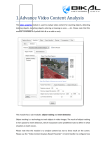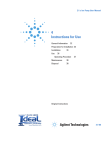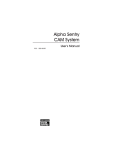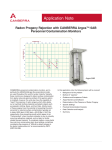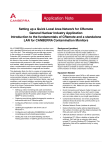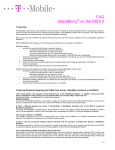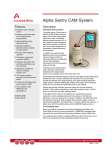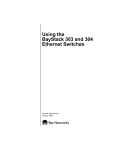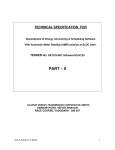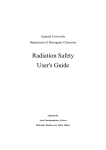Download Passive Whole Body Monitoring Application Note
Transcript
Application Note Passive Whole Body Monitoring Nuclear Power Industry Application Introduction to the Argos™-5AB Zeus™ (Gamma Option) and the GEM™-5 Gamma Exit Monitor CANBERRA’s personnel contamination monitors, the ARGOS-5AB with the Zeus (plastic gamma scintillator) option, and the GEM-5 gamma exit monitor, are used throughout the world’s nuclear industry. Typically these monitors are designed to detect surface contamination from alpha, beta and gamma emitters, however, the units also have the capability to detect internal deposition at levels less than 1% of an annual limit of intake[1] (ALI) when configured to alarm at the typical 5000 dpm beta /1000 dpm alpha, and gamma activity of either 25-35 nCi (925-1295 Bq) Co-60 or 65-75 nCi (2405-2775 Bq) Cs-137. The passive monitoring can be easily accomplished in background fields of 10-25 uR/h (100-250 nSv/h) using count times based on achieving the typical external surface contamination detection capabilities listed above. In this application note, the following topics will be covered: • The CANBERRA ARGOS-5AB with Zeus and GEM-5 Monitors • Argos Monitor Shielding • Monitor Software • Guidance and Acceptance Criteria • Practical Considerations for Passive Monitoring • Optimization of Gamma Detector High Voltage • Calibration of Alpha/Beta and Gamma detectors • The Phantom • Determination of Typical Self Shielding and Setback distances • MDA Determination • Reliably Detectable Activity (RDA) Results • Summary The ARGOS-5AB with the ZEUS option as typically configured at many nuclear power facilities (and as tested for this application note) includes twenty-four (24) gas flow proportional detectors, three (3) large area gamma plastic scintillators, a single gamma foot detector, and the alpha/beta moving head option. A number of pictorial representations of the detector layout can be seen in Figures 1 and 2. The CANBERRA ARGOS-5AB with Zeus Monitor The Zeus Option on an ARGOS monitor consists of the following major components Figure 1: An individual monitored upon exiting from the RCA steps into the ARGOS-5AB and faces the detectors, is guided into position with verbal and visual prompts, is monitored on the front of the body and right hand/arm, the individual turns and positions with guidance and is monitored on the back of the body and left hand/arm. Passive monitoring sensitivity is increased when the unit is set to “Monitor Body in Two Steps =YES” this enables the unit to sum the front and back gamma count results and take advantage of the longer count time. In effect, enabling the performance of a gross gamma whole body gamma count with sensitivity capable more than sufficient to complete passive monitoring. 1. Three (3) large plastic gamma scintillators monitoring the body. 2. A 1 in. (2.54 cm) lead shielding curtain wall. 3. ~0.4 in. lead shielding surrounding the back and sides of the plastic scintillators. 4. A single plastic gamma head scintillation detector. In addition, specific monitoring results, both front and back count data, can be linked to an individual worker through the use of an “ID Badge” reader which may take the form of a barcode scanner, a magnetic card, or a proximity card reader. In this way each individual has a unique record which can be saved and archived. Figure 1 Full Zeus Option on the Argos-5AB 1 • Similarly the American Nuclear Insurers (ANI) notes in ANI Section 8.5 Radiation Protection Bioassay. Typical field implementations have replaced the single gamma head detector with a gas flow alpha/beta moving head detector, and instead implemented a gamma foot detector option in the detector 1 position (see Figure 2). “The Entrance and Termination Whole Body Counts are preferred; however, credit may be taken for passive monitoring if internal sensitivity studies have been performed on the PCMs or PMs”. Specific performance criteria for the determination of monitor sensitivity are listed in section 8.5.9 and will be discussed in this application note. [2] • What constitutes detection of ≤ 1% of an ALI? Figure 2 Alternative layout, gamma detectors in green Since an intake of radioactive materials via inhalation is larger than the actual retention, and we are measuring the amount retained in the body when one performs either whole body counting or passive monitoring we need to adjust the quantity for detection success by the amount retained during the same day as the intake. The intake retention fraction can be approximated ~0.63 of the 1% of an ALI for the purposes of this calculation, assuming a particle size of approximately 1μ AMAD. So for example, the consistent detection of less than ~192 nCi (7.1 kBq) of Co-60 and less than ~1276 nCi (47.2 kBq) of Cs-137 would denote success based on an ALI of 30 and 200 µCi (1.11 and 7.4 MBq) of Co and Cs, respectively. The Shielding The complete shielding package includes both 2.5 cm (1 in.) curtain shielding wall and approximately 0.4 in. of lead surrounding the plastic scintillators. The lead features: • Modular epoxy coated lead ingot design for ease of handling and installation. • Each lead ingot weights approximately 20 lbs. The lead surrounding the scintillators weights typically less. • The curtain wall provides “shadow shielding” for the plastic scintillators. Practical Passive Monitoring Argos Monitor Software Passive Gamma monitoring is not new, but with CANBERRA’s Zeus option, it can be achieved simultaneously at the point of exit from the RCA while surface contamination monitoring is conducted. Workers exiting the RCA are effectively monitored on at least a daily basis, if not multiple times, in lieu of a daily or routine Whole Body Count (WBC). A GEM-5 unit can also perform this function at the exit point to the Controlled Area. This monitoring also provides a record of monitoring if the worker fails to return or complete their termination whole body count. Setting up to perform and document the internal detection capability of passive monitoring should include the following elements: The monitor software includes utilities and data collection and archiving capabilities which enable the easy collection of calibration, self-shielding, and alarm testing data to properly record and document your passive monitoring capability. Consult the User Manual and the CANBERRA Services and Application Support Group (ASG) for assistance or services to complete testing. Applicable Guidance and Acceptance Criteria • The Institute of Nuclear Power Operations (INPO) and the American Nuclear Insurers (ANI) Regulatory bodies have acknowledged the performance of “passive” monitoring to either replace or augment routine whole body counting. For example, INPO states the following: • Outline a test plan and the steps needed to complete the testing. Determine the sources available for testing, the various combinations of sources to be used, and the ratios of radionuclides that make up the typical plant mix. Target various levels and work your way up from 0.1 to over 1% of an ALI. A good series of increasing activities are from 0.1, 0.2, 0.3, 0.5 0.75, 1 and 1.5%. “Passive monitors (some gamma-sensitive whole-body contamination monitors and portal monitors) at the exits from the RCA and wholebody counters are used to routinely monitor personnel for internally deposited radioactivity. If passive monitoring is used to replace routine whole-body counting, evaluation and testing must be completed to determine the appropriateness and limitations of the program. Testing should be plant-specific and should not rely solely on evaluations done by other stations.” [1] • While a plant specific radionuclide mix is ideal, Co-60, Co-58, and Cs-137 sources can be used. Once the MDA is established for the gamma emitters, the facility should use scaling factors to determine the total MDA given the plant mix and including “hard-to-detects”. 2 • If the plant mix changes significantly (based on your pre-defined conditions) to affect the passive monitoring, you may need to repeat this testing. You should reevaluate the use of passive monitoring equipment whenever analysis of the reactor coolant indicates that fuel leaks are present or have increased by a factor of 10. • Use of a phantom/setup which adequately represents the attenuation and self-shielding behavior of a “standard man”. A phantom with a variable chest wall thickness is desirable, but using a thick chest wall will provide the most conservative results. • Evaluation and documentation of the self-shielding effects of others standing in proximity to the monitors on the minimal detectable activities and establishing “setback” distances to control these affects to achieve MDAs consistently less than 1% of an ALI. • Document the results of the testing by meeting formal administrative requirements and review/ approval cycles. Including dates, signatures, review and approvals, individuals performing, reviewing and approving the results. Other information including serial numbers of equipment including sources, the location of the testing and orientation of the monitors. List all conclusions and capabilities for the passive monitoring. • Optimization of the gamma detectors high voltage to obtain the best overall efficiency for the representative plant mix of radionuclides. Or using the monitor as configured and documenting the monitor’s capabilities and limitations. • Configuring the monitor’s software to perform the same in alarm test mode during testing as it would during routine personnel monitoring. Gamma Detector High Voltage Optimization The high voltage of the plastic scintillators needs to be optimized for the best performance with the plant mix and/ or calibration sources. Changing this high voltage affects the sensitivity of the monitors as well as the background count rates, and if changed after performance of the passive monitoring capability testing, the impact of this change needs to be assessed. The two radionuclides typically used for optimization in the US are Co-60 and Cs-137. Optimization with the lower energy Cs-137 increases the monitor’s sensitivity to lower energy emitters such as I-131 or Tc-99m typically used for medical diagnostic scans. A utility for optimization exists within the ARGOS and GEM-5 monitors based on a Figure of Merit (FOM) calculation [3]. • Using radioactivity standards traceable to the National Institute of Standards and Testing (NIST) or other equivalent testing laboratory for calibration, alarm testing, and testing with the phantom. A detector calibrated with appropriate standards can also be used to assay sources used for passive monitoring capability. • Documenting both the detector background and the background exposure rates at the monitors’ present location. A diagram with dimensions of the monitors’ location should also be made, particularly in relationship to radiation sources, if present. • Documenting the details of the phantom (dimensions, and other characteristics), the location of the phantom in the monitor, the location of the source loading in the phantom. Photographic documentation of the setup shall also be generated. Calibration of Alpha/Beta and Gamma detectors Determination of the response of detectors, calibration of all systems as tested for efficiency and activity alarm levels needs to be documented as the chosen alarm setpoints for typical personnel monitoring affect the performance/ sensitivity of passive monitoring. If the alarm setpoints are changed, or the unit re-calibrated, the affect on the passive monitoring needs to be evaluated. Re-calibration of the units plastic gamma scintillators, unless a different radionuclide is used from that used during the initial performance testing or the efficiency deviates significantly (decreased by >25%), does not affect the ability of the monitors to achieve the 1% ALI sensitivity. This is due to the fact that ARGOS with the Zeus option’s MDA is typically less than 0.30% of an ALI. More significant is the changing of the gamma alarm levels. • Define the specific conditions for successful “detection” and what constitutes the Minimal Detectable Activity (MDA) for a system. ANI constitutes the successful establishment of an MDA to be the successful counts of an activity less than or equal to 1% of an ALI 10 out of 10 times for gamma emitters. Perform at least 10 counts with each source strength leading up to the establishment of the MDA. • If multiple monitors are present within the same location, determine if the monitors all behave in a similar fashion, or if conditions due to shielding/ positioning will affect the MDA. When in doubt, consider testing of all/additional monitors at that location. Once the calibration is completed, the unit needs to be alarm tested successfully and placed into service for approximately five minutes for background acquisition to occur prior to conducting testing for passive monitoring testing. 3 The Phantom The phantom is then reassembled and placed in the ARGOS supported by a stand in the monitor to simulate an individual during monitoring. This phantom satisfies the HPS N13.30-1996 Performance Criteria for Radiobioassay [4] standard for calibration and testing of counting systems for measurements of activity in the lungs. Other phantoms may also be used. CANBERRA currently uses a Livermore Realistic torso phantom for all passive monitoring test measurements it performs. The prototype Livermore Realistic torso phantom was designed by Lawrence Livermore National Laboratory (LLNL) to accurately simulate the torso, rib cage and lungs of a reference counting subject. The phantom pictured in Figure 3 was manufactured by and purchased from Humanoid Systems Inc. Self Shielding Determination and Setback distances Self-shielding of the gamma detectors by occupants in the monitors, as well as individuals congregating near the monitors can artificially lower the background count rate seen by the gamma detectors. While the ARGOS units can detect changing background during the actual count and notify an individual to re-monitor based upon user defined statistical criteria, people congregating near monitors during shift changes can artificially lower the overall background. This is why stanchions and setback lines are typically seen at RCA and controlled area exit points around gamma sensitive personnel and tool /object monitors. The typical or average self-shielding by an individual within the monitor can be set using a utility “Optimize Self Shield Factors” within the monitor’s software enables the automatic setting of this self shielding factor. This utility helps compensate for these effects. Statistical settings for background re-set and update are also available within the software to update this changing background. Since the monitor adjusts the count time for each individual to meet a pre-defined alarm setpoint this is not a problem for normal release criteria. The monitor’s count time is usually driven by the count time required for either the alpha and beta detection limits, so under typical conditions the passive monitoring capability remains unaffected. Figure 3 Livermore Realistic Phantom This phantom simulates the upper torso of a reference counting subject. It extends from the base of the neck to just below the lower margin of the liver, and is constructed without any head, neck, arm, or lower torso components. A durable soft-tissue equivalent material is molded about a bone-equivalent skeleton. The interior thorax cavity is completely filled with removable organs and filler material to eliminate air spaces. The inner organ components are accessible by removing the primary torso cover plate. This primary cover plate contains a simulated sternum component and the balance of the simulated ribs. Additional chest overlay plates can be used to simulate subjects with varying chest wall thickness values. The overlay plates are primarily used for calibrations of lung counters when measurements of transuranic radionuclides are made. In these measurements the thickest overlay is used with the primary plate for a total average chest wall thickness of 39.1 mm. Tests with and without the overlay were made when the MDA was reached and no changes in the MDA were observed when using either Cs-137 or Co-60. This phantom includes lung, lymph node, and abdominal inserts and is ideally suited for lung activity distribution calibrations. The phantom can also be used as an “appropriate blank” with inert lungs to evaluate background counting levels and detection limits. The lung inserts are sectioned to enable the placement of sources throughout the lungs as pictured in Figure 4. Sources may be distributed throughout the phantom lung set when multiple sources are used. For single sources the sources should be placed in the center of each lung set towards the centerline of the phantom. The distribution of the sources in either the left or right lung does not appear to affect the monitor’s MDA. Figure 4 Sectioned lungs with radioactive disk source 4 Once the self-shielding characteristics have been determined for an “average” worker, the phantom and the stand used to hold the phantom in position should be placed in the monitor and an assessment of the phantom/stand assembly’s self-shielding determined. As seen in Figure 5, the phantom and stand have been placed in the monitor. Note that the platform/holder has been designed to hold the torso at the same approximate height of a “standard man”. CANBERRA’s new AccuRate Morphological self-shielding correction methodology performs such corrections on an individual basis, and not just an average individual. This method helps extend the monitor’s passive monitoring capability to workers who deviate significantly from the norm. Once the MDA was determined (10/10 “Contaminated” indications), the phantom and sources were left in the monitor in alarm test mode and individuals approached both sides of the monitor (RCA and “Clean Side”) until the self-shielding from these individuals resulted in a “Clean” rather than “Contaminated” indication. Each individual then moved back from the monitor in incremental steps until the monitor successfully enunciated an alarm “Contaminated” condition. Setback lines can then be established to maintain the required passive sensitivity. In this case, the selfshielding properties of both the phantom and the support platform were determined to be comparable with a Figure 5 normal individual standing Phantom and platform in the monitor. The in the Argos platform’s design, while meeting the self-shielding characteristics, also provided a stable surface which aided in the repeated positioning of the phantom (weighing ~60+lbs) after various source activities were loaded. MDA Determination After the self shielding factors have been determined and loaded into the monitor software, the phantom and platform are removed and the unit is placed into normal service and the background is allowed to collect for approximately 5 minutes. Once setback lines are established, it is suggested that the same conditions be repeated during a routine shift change with the phantom be placed in the monitor with sources at, or slightly above the MDA (but less than 1% of an ALI) to verify setback distances and monitor performance. Again, since the MDA and the units are less than 0.30% of an ALI, once setback lines are established for the lower MDA, the units can easily maintain their passive monitoring capability. Incremental source activities are loaded into phantom lung set and the platform and phantom staged away from the monitor to avoid any influence on background acquisition. The monitor is then placed into Alarm Test mode, and the phantom and platform placed into the monitor. Approximately 12 to 15 monitor cycles are allowed to complete to determine if the activity alarms the monitor. After each attempt the phantom and platform are removed and the monitor is taken out of service. Alarm test files for each activity sequence are organized and filed. The alarm test files provide a date and time stamped record of which detectors alarmed (Figure 6) and (Figure 7) the directory of Alarm Test Results files with “_C” indicating a contaminated determination. The monitor is then placed back into service. Figure 6 Contaminated determination in alarm test file Figure 7 Alarm test files in directory Summary The source activity is increased in the phantom and the testing cycle is repeated until the monitor successfully registers “Contaminated” on one or more detectors 10 or more consecutive times to determine the MDA. With the ARGOS unit this is confirmed by a visual display on the monitor seen in Figure 8 and accompanied by an audible “Contaminated” voice notification. ARGOS whole body contamination monitors with gamma detection capability and GEM-5 gamma exit monitors have been shown to detect intakes at levels less than 1% of the annual limit of intake (ALI) and are a resource to perform passive gamma monitoring. Implementation of a passive gamma monitoring program can help you to: • Maximize performance of your facility controlled area and RCA monitoring equipment by performing passive gamma monitoring while simultaneously conducting surface contamination monitoring. • Quickly identify personnel who need additional follow up and possible internal dosimetry evaluation. • Augment your routine Whole Body Counting (WBC) program by identifying personnel who need additional investigational monitoring each time they leave the RCA and /or the controlled area, or minimize the routine counts performed using your whole body counting equipment. Figure 8 Typical Argos display during a successful contaminated event Reliably Detectable Activity (RDA) Results Results of the testing for Co-60 and Cs-137 yielded RDAs at this facility of 44.6 nCi (1650Bq) or ≤ 0.23% ALI and 90.3 nCi (3341Bq) or ≤ 0.07% ALI respectively. These results were consistently obtained for four (4) ARGOS-5AB with Zeus gamma scintillators optimized for Cs-137 located at the same RCA exit point. GEM-5 contamination monitors perform in a very similar fashion. In the pause and wait mode they reach similar detection levels for passive monitoring, and in the two-step mode they can exceed the detection sensitivity of the ARGOS-5 Series monitors with the Zeus Option. The gamma activity alarm set points for these units were all set at 25 nCi (925 Bq) for Co-60, based on a point source efficiency calibration at 7.5 cm (3 in.) from the body surface detectors. Surface contamination alarm set points were set at 4500 dpm beta and 1000 dpm alpha. • Retain a record of passive monitoring if a worker fails to return or complete their exit /termination whole body count. CANBERRA’s ARGOS-5AB with Zeus Monitor and GEM-5 exit monitor have been demonstrated to fulfill Passive Monitoring capability when correctly implemented. CANBERRA offers a Passive Monitoring Qualification and Evaluation service to help you to perform the plant-specific activities necessary to take credit for your passive gamma monitoring program. Please contact your sales representative to learn how Passive Monitoring can be implemented in your facility and to obtain customer references. References [1] Institute of Nuclear Power Operations (INPO) INPO 05-008 Guidelines for Radiological Protection at Nuclear Power Stations (2005). [2] American Nuclear Insurers (ANI) ANI Section 8.5 Radiation Protection Bioassay (2008). [3] Argos-3/-5 Whole Body Surface Contamination Monitors, User’s Manual, Canberra Industries (2010). [4] HPS N13.30-1996 Performance Criteria for Radiobioassay (1996). Zeus is a trademark of Canberra Industries, Inc. Argos and GEM are trademarks of Canberra Co. Measurement Solutions for Nuclear Safety and Security CANBERRA is the Nuclear Measurements Business Unit of AREVA n For more information please visit: www.canberra.com C39962 – 11/12 6







